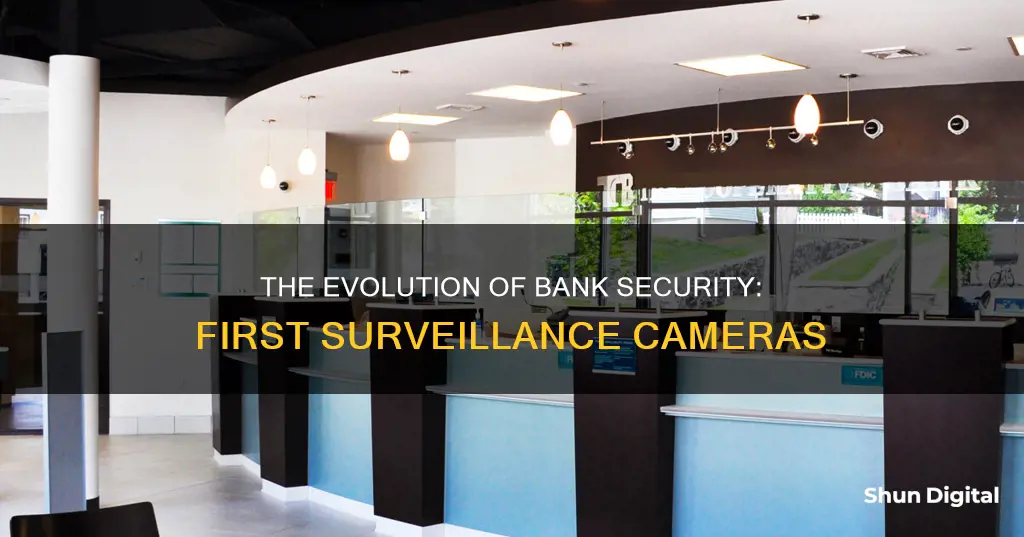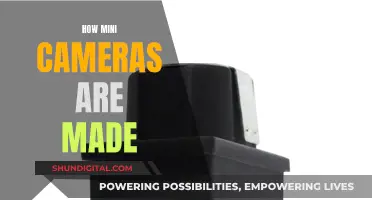
The history of surveillance cameras can be traced back to the 1920s, when the first closed-circuit television (CCTV) system was invented by Russian physicist Léon Theremin. However, it wasn't until the 1940s that the first commercial CCTV system, Vericon, became available in the United States. This system was designed by CBS Laboratories and sold by Remington Rand. At this time, CCTV systems were primarily used for security in businesses and public places, rather than in private homes. It wasn't until the late 1970s that security cameras became more common in business places. The 1990s saw the arrival of the first internet protocol (IP) cameras, which sent video signals as digital encoded signals over the internet, marking a significant shift in the industry. Today, security cameras are ubiquitous, with over 1 billion cameras installed worldwide.
| Characteristics | Values |
|---|---|
| First surveillance camera system invented | 1926 by León Theremin |
| First CCTV system | 1927 by Léon Theremin |
| First commercial CCTV | 1949 by Vericon |
| First videotape recorder | 1951 |
| First IP camera | 1996 by Axis Communications |
What You'll Learn
- The first surveillance cameras were developed in the 1920s by Leon Theremin
- The first commercial CCTV system was introduced in 1949
- CCTV became more accessible to businesses and banks in 1949
- CCTV systems were installed in banks in the 1970s and 1980s
- Surveillance cameras became more common in the 1990s

The first surveillance cameras were developed in the 1920s by Leon Theremin
The history of surveillance cameras can be traced back to the 1920s, with the earliest version of a security camera invented by Leon Theremin. Theremin, a Russian physicist, created a closed-circuit television (CCTV) system using a camera and a shortwave radio. This system was used to monitor visitors at the Kremlin in Moscow and is considered the first CCTV system.
Leon Theremin is known for inventing the world's first electronic musical instrument, the theremin. In the late 1920s, he worked on "distance vision", a mechanical form of CCTV. His invention was demonstrated to Joseph Stalin before being classified by the Soviet army. Unfortunately, Theremin's CCTV system was never put to use, and he gained greater fame for his contributions to electronic music.
The early CCTV system had a low resolution of only 100 lines, resulting in grainy and unclear images. However, it laid the foundation for the development of surveillance technology. It is important to note that the first CCTV system was not designed for banks, but for monitoring visitors at the Kremlin.
It wasn't until the 1940s that the next significant development in CCTV technology occurred. In 1942, German engineer Walter Bruch designed a CCTV system for Nazi Germany to monitor the launch of V-2 rockets. This system was also used by the American military to test atomic bombs. However, both Theremin's and Bruch's systems lacked recording capabilities, requiring constant monitoring of the live feed.
The first publicly available CCTV system was introduced in 1949 by an American company, marking the beginning of the widespread use of CCTV for security purposes. In the 1950s, the invention of the videotape recorder (VTR) further advanced the functionality of CCTV systems. The integration of VTRs with CCTV cameras enabled the recording of live video footage, making it a practical security solution.
The evolution of CCTV technology continued with the introduction of colour cameras in the 1950s, although black-and-white cameras were preferred for surveillance due to their higher resolution and better low-light performance. The development of charge-coupled device (CCD) technology in the 1970s improved low-light imaging and paved the way for true night vision capabilities.
The 1970s and 1980s saw the widespread adoption of CCTV systems in banks and retail stores to prevent theft. The technology continued to advance, and by the 1990s, digital systems offered improved storage capacity and image quality, making them a more attractive option than analog cameras.
Replacing Sanyo Camera Battery: Step-by-Step Guide
You may want to see also

The first commercial CCTV system was introduced in 1949
The first commercial closed-circuit television (CCTV) system was introduced in 1949 by an American company called Vericon. This marked a pivotal moment in the history of surveillance technology, making security cameras accessible to businesses, banks, and private residences.
Prior to the introduction of commercial CCTV, the use of surveillance cameras was largely confined to military applications. The earliest version of a security camera was invented in the 1920s by Leon Theremin, a Soviet inventor known for creating the theremin, an electronic musical instrument. This early system was a type of mechanical CCTV and was presented to Joseph Stalin before being classified by the military.
Following Theremin's invention, German engineer Walter Bruch designed a CCTV system for the Nazis in 1942 to monitor V-2 rocket launches. However, these early systems had limitations and could not record footage, requiring constant monitoring.
The introduction of the Vericon system in 1949 represented a significant advancement. It did not require a government permit to operate, as it utilised cabled connections between the camera and monitor instead of wireless transmission. This made CCTV more accessible to civilian entities, marking a shift from exclusively military applications.
While the Vericon system still relied on constant monitoring, the development of reel-to-reel media and the emergence of videotape recorders in the 1950s enabled the recording of surveillance footage. However, these methods were time-consuming, expensive, and unreliable, limiting the widespread adoption of video surveillance.
It wasn't until the 1970s, with the introduction of videocassettes and the development of digital multiplexing, that surveillance cameras gained mainstream popularity. The combination of CCTV with VCR technology allowed for the recording, reviewing, and storage of security footage, making it feasible for businesses and individuals to implement surveillance systems.
Over the following decades, advancements in camera quality, low-light performance, and digital storage further propelled the widespread adoption of surveillance cameras. The introduction of internet protocol (IP) cameras in the 1990s, which transmitted footage wirelessly over computer networks, represented another significant milestone in the evolution of surveillance technology.
Enhancing Wireless Surveillance Camera Range: Tips for Better Reach
You may want to see also

CCTV became more accessible to businesses and banks in 1949
The first commercial closed-circuit television (CCTV) system was made available in 1949 by Remington Rand, designed by CBS Laboratories. Called "Vericon", it was the first publicly available CCTV system and did not require a government permit to operate. This was a significant development as it made security cameras more accessible to businesses, banks, and private residences, rather than being restricted to military use.
Prior to 1949, the earliest versions of security cameras were developed in the 1920s by Leon Theremin, who invented a mechanical form of CCTV known as "distance vision". This system was demonstrated to Joseph Stalin and later classified by the Soviet army. In 1942, German engineer Walter Bruch designed another early CCTV system for the Nazis to observe V-2 rocket launches. However, these early systems were not widely adopted for security purposes.
The introduction of the Vericon system in 1949 marked a turning point, making CCTV technology more widely available to civilian entities. This accessibility was further enhanced by the development of videotape recorders (VTRs) in the 1950s, which enabled the recording of surveillance footage. However, the use of video surveillance remained limited due to the high cost and cumbersome nature of the equipment.
It wasn't until the 1970s that CCTV systems with VTRs became more common in businesses, banks, and retail shops. The development of charge-coupled device (CCD) technology in 1976 further advanced the capabilities of surveillance cameras, enabling low-light imaging and continuous monitoring.
In summary, while the foundations of CCTV technology were laid in the 1920s and 1940s, it was in 1949 that this technology became more accessible to businesses and banks, marking a significant step towards the widespread adoption of security cameras that we see today.
Understanding FE2 Camera's Battery Functionality
You may want to see also

CCTV systems were installed in banks in the 1970s and 1980s
The 1970s and 1980s saw the installation of CCTV systems in banks to prevent theft. This was made possible by the introduction of VCRs in the 1970s, which allowed for the recording of remote surveillance for later viewing. The use of CCTV in banks became more common in the 1980s, with the technology becoming more affordable and accessible. These CCTV cameras were connected to monitors with cables, and while they were effective, they were also large and drew attention to themselves.
The first CCTV systems became available in 1949, but these early systems did not have recording capabilities and required constant monitoring. The development of reel-to-reel media enabled the recording of surveillance footage, but this was a time-consuming and expensive process. The introduction of VCRs in the 1970s revolutionised the way CCTV could be used, making it more practical for security purposes.
The CCTV systems installed in banks in the 1970s and 1980s would have been a significant upgrade from the previous generation of security cameras. The new systems offered higher resolution and clearer images, especially in low-light conditions. They were also more discreet and easier to install. These advancements made CCTV a more attractive option for banks and other businesses looking to enhance their security measures.
The installation of CCTV systems in banks during this period also coincided with a broader trend of increasing CCTV usage in public and private spaces. Retail shops, ATMs, and other businesses followed banks in adopting CCTV technology to deter crime and improve security. This trend continued into the 1980s, with video surveillance becoming more widespread and accepted.
Iron Cameras: Myth or Reality?
You may want to see also

Surveillance cameras became more common in the 1990s
The 1990s saw the introduction of the first IP (internet protocol) cameras, which were the forebears of the modern web and surveillance cameras. The first IP camera, the Axis NetEye 200, was released in 1996. This camera could transmit footage wirelessly over a computer network, removing the need for a closed-circuit system. However, IP cameras were not widely accepted at first, as analogue security dealers did not initially grasp the concept.
The 1990s also saw the advent of digital video recorders, which contained hard disc drives that could capture and store recorded video, eliminating the need for tapes. These recorders could store large amounts of digital video.
The development of digital multiplexers in the mid-1990s allowed a single digital video recorder (DVR) to capture and save footage from multiple cameras, leading to the multi-camera security systems that are commonly used today.
Cameras also became smaller and more specific in the 1990s, with the first "Nanny Cam" being released in 1992.
The improvements in camera technology and the rise of IP cameras in the 1990s made surveillance cameras more accessible to the general public, leading to their increased use in homes and businesses.
How to Improve Your Camera's Focus Quality
You may want to see also
Frequently asked questions
The earliest version of the security camera was invented in the 1920s by Leon Theremin.
No, they were initially used by the military.
The first publicly available CCTV system was sold by a US company in 1949.
Banks started using CCTV systems in the 1970s and 1980s.
The early cameras had a resolution of only 100 lines, creating a grainy and unclear picture.







